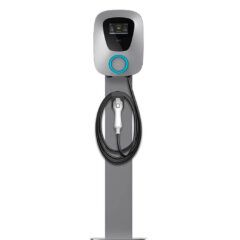Which is the best place to install evse charging station?

Charging an electric car is easier than you think, and it’s getting easier and easier. It still takes some planning compared to a traditional internal combustion engine car. This particularly on longer journeys, but as the evse charging station grows and the car’s battery life increases, it is less and less likely that you are caught unprepared.
Charging an electric car: the options to choose
There are three main ways to charge your EV at home, at work, or using a public charging point on the side of the road or at a gas station. Plus, if you have a Tesla, there’s the company’s Supercharger network that includes over 800 sites.
It comes from highway services to numerous hotels and shopping malls. Finding any of these chargers is fairly straightforward, with most EVs featuring satellite navigation with tracked sites, plus mobile apps showing you where they are and who runs them.
Public evse charging station offers a number of ways to pay. Similarly, it comes often via a special card or payment application on your phone. That said, many charging stations increasingly equip with contactless technology. This means it is possible to pay with a regular debit or credit card.
Ultimately, where and when you charge depends on how and where you use the car.
However, if an electric vehicle fits your lifestyle, the likelihood is that most of your charging will come at home overnight. Moreover, it comes with only short recharges at public charging points when you’re out and about. The time it takes to charge the car essentially depends on three things:
- the size of the car’s battery
- Moreover, the amount of electric current the car can handle
- and the speed of the charger.
The most expensive models in his collection
Battery size and power express in kilowatt hours, or kWh, and the larger the number the larger the battery, the longer it will take. Chargers provide electricity in kilowatts (kW), with anything from 3kW to 150kW possible. The higher the number the faster the recharge rate will be with evse charging station.
Use the simplest charger and even a Nissan Leaf with a 40kWh battery will take up to 12 hours to fully charge. Conversely, the latest fast-charging devices, usually found at gas stations, can add up to 80% of a full charge in half an hour.
So which charger is the best?

Charging an electric car: types of chargers
There are essentially three types of chargers: slow, fast, and quick. Slow and fast chargers are usually common in homes or for charging points on the road. For a fast charger you need to visit a dedicated service station or charging hub.
Some connect which means that like petrol pump the cable attaches and simply connects to the car. Similarly, others require the use of its own cable. Hence, you have to carry around in the car. Here is a guide for each.
Charging an electric car: slow charger
This is typically a home charger that uses a regular home plug. With ever larger batteries you can expect charging times of up to 24 hours for some of the larger pure EV models. Some older road-side charging stations also provide this rate, but most have been upgraded to run at 7kW on fast chargers.
Almost everyone now uses a Type 2 connector thanks to the 2014 EU regulations, which require it to become the standardized charging plug for all electric vehicles.
Charging an electric car: fast chargers
Typically delivering electricity between 7kW and 22kW, fast chargers are becoming more and more common, particularly at home. Known as evse charging station, these units typically charge up to 7kW, reducing the time it takes to recharge the battery by roughly half. Fitted in your garage or car, these units will need to be installed by an electrician.
There are currently some grants that cover up to 75 percent of the purchase cost. Prices start at around £ 400 after the grant. However, some automakers will pay for a charger and installation when you buy one of their EVs, so it’s worth keeping an eye on the offers.
Where to install evse charging station?
Public fast chargers tend to place locations, and usually come on the roadside or in hotel parking lots. You will have to pay for these units as you go, either by signing up for an account with the top-up provider or by using normal contactless bank card technology.
Charging an electric car: quick charger
As the name suggests, these are the fastest and most powerful chargers. They usually operate at speeds between 43kW and 150kW, and can operate in direct or alternating current. In some cases, they can restore 80% of the charge of even the largest battery in just 20 minutes.
Evse charging station is usually common at highway services or dedicated charging hubs, so it’s perfect when planning a longer trip. Most fast chargers run at 50kW, but there are more and more that can charge at 100 and 150kW. Tesla, by the way, has some 250kW units.
However, that figure is also improved by the charging company Ionity, which has begun a roll out of 350kW chargers at a handful of sites. Unfortunately, not all cars can handle this amount of charge.
Charging an electric car: what are RFID cards?
An RFID, or Radio-Frequency Identification, gives you access to most public evse charging station. You will receive a different card for each energy supplier, which you will have to pass over a sensor on the charging column to unlock the connector and allow the flow of electricity. Your account will then be charged with the amount of energy you use to recharge your battery.
However, many vendors are phasing out these cards in favor of a smartphone app. Not only that, but they are also taking advantage of payment by bank card: the latter is slightly more expensive as it does not require the registration of your data.

